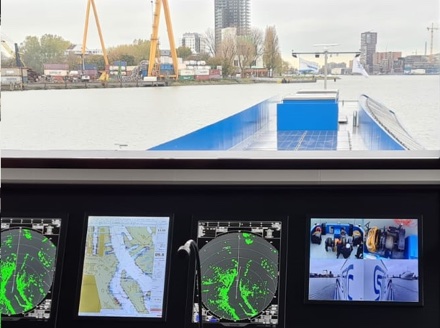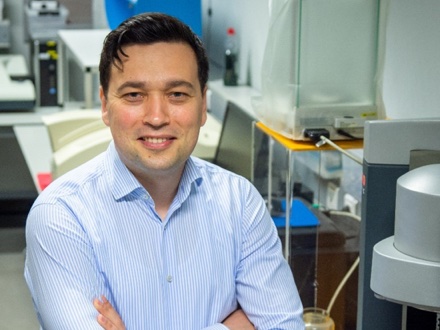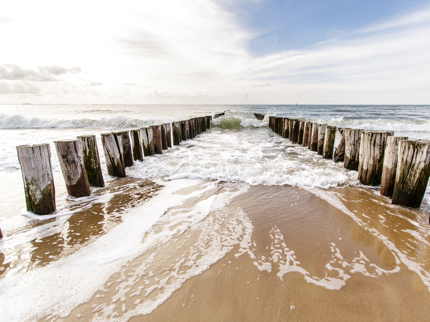 Ships are the most efficient way to transport goods in the world, consuming less energy per cargo unit than road, air and railway transport. However, shipping still accounts for 2,7% of global Greenhouse Gas (GHG) emissions, a percentage that will only grow if no actions are taken to reduce it. The NWO-NWA project PATH2ZERO focuses on the subarea of inland shipping and aims to develop a digital twin to help the inland sector reduce GHG emission intensity to zero by 2050. In this interview assistant professor Alex Kirichek from TU Delft clarifies the plans.
Ships are the most efficient way to transport goods in the world, consuming less energy per cargo unit than road, air and railway transport. However, shipping still accounts for 2,7% of global Greenhouse Gas (GHG) emissions, a percentage that will only grow if no actions are taken to reduce it. The NWO-NWA project PATH2ZERO focuses on the subarea of inland shipping and aims to develop a digital twin to help the inland sector reduce GHG emission intensity to zero by 2050. In this interview assistant professor Alex Kirichek from TU Delft clarifies the plans.
Photo: View from bridge Ab Initio - by Mark van Koningsveld - llicenced under CC BY-SA 4.0
Alex, what is your position at TU Delft?
“I am an Assistant professor of Ports and Waterways at the Faculty of Civil Engineering and Geosciences, working closely with professor Mark van Koningsveld. My research is focused on different port related subjects like maintenance, infrastructure, nautical safety, sustainability and digitalization. I am passionate about bridging fundamental and applied research to societal and industrial challenges like climate change, energy transition, circular economy and resilient infrastructure. PATH2ZERO is an excellent example of society-driven projects. It has a solid consortium of more than thirty partners including academia, industry, research institutes and governmental organizations."
Can you tell a bit more about PATH2ZERO?
“PATH2ZERO stands for PAving THe way towards Zero-Emission and RObust inland shipping. One of the main goals of this NWO-NWA project is to develop a digital twin model of the waterway network for testing the efficiency of newly developed solutions for reducing GHG emissions from inland shipping. Focusing on the golden triangle of individual vessels, logistic chains and fuelling infrastructure, we enable all parties in the sector to thoroughly weigh the impact of potential interventions. You can think of implementing new technologies in individual vessels, like switching to a hydrogen engine or building new bunkering stations, to changing the policy measures for an entire shipping corridor. At this point, we are aligning all partners and getting the documents ready for the official kick-off in early 2023. Then we will have six years to make a step forward towards zero-emission shipping in 2050.”
Why do we need a digital twin to reduce GHG emissions?
“In inland shipping, everything is connected. For example, if we retrofit one ship in the fleet to hydrogen fuel, we have to build new bunkering stations that supply this new energy form. In this way we dive into a whole new market with associated work opportunities, governmental policies and permits. We should also combine these newly developed bunkering stations with other solutions, like reducing waiting times at locks and bridges and optimizing the loading/unloading of ships. Companies that work within the sector have to adapt to new policies and accept new business models. By now you can imagine that it is vital to calculate the consequences of our innovations for the whole chain, before we start acting.”
What is your ultimate goal?
“Our ultimate goal is that the sector of inland shipping will be emission free in 2050. In order to achieve that, we have to test the efficiency of short term solutions that already could make a huge difference. For example, if we could manage to reduce the emission of inland shipping with 5-10% in one year, that would already be a lot. How we are going to change the sector, depends on the breakthroughs we can achieve. I usually explain this by the example of the candle. When the candle light couldn’t be improved anymore, we switched to alternative energy products, like a gasoline lamp. At this point in time, we are in a similar situation: fossil fuels can’t help us any further. We have to come up with completely new ways, like hydrogen, ammonia, green energy sources or something totally different.”
How will PATH2ZERO help to find these new ways?
“Actually, I think it is going to help a lot. For a long time, the inland shipping sector hasn’t been eager to change, because vessels have a long lifetime and the sector is very competitive. However, at this point, we counted more than 150 maritime research initiatives in the EU that are focused on emissions. When we can bring all this knowledge together by using the grant we got from NWO-NWA, we can really make a difference. Moreover, we already hooked up some very important parties, like Rijkswaterstaat and port of Rotterdam, port of Amsterdam and North Sea Ports, but also private parties like ship building, transport and logistic companies. By collaborating in multiple working groups, we will select a number of potential measures, test their efficiency in the digital twin and adapt the results for making new policies and developing new business models. The role of policy makers and the governmental organisations is to adapt the findings of PATH2ZERO and to implement these new types of solutions during the project and after the project is finished.”
What do you see as the biggest challenge?
“I think it would be great if the acceptance and uptake of innovations can be faster. It is really important to drag the stakeholders along so they will understand the benefits of change when the time comes. I think DigiShape is already helping in making this shift by stimulating collaboration between companies. It creates an environment where sharing data and multiplying knowledge becomes more natural. DigiShape is surely one of the key partners and we intend to work closely together on disseminating the knowledge that we achieve in this project.”
 More information
More information
Contact Alex Kirichek at Dit e-mailadres wordt beveiligd tegen spambots. JavaScript dient ingeschakeld te zijn om het te bekijken.

